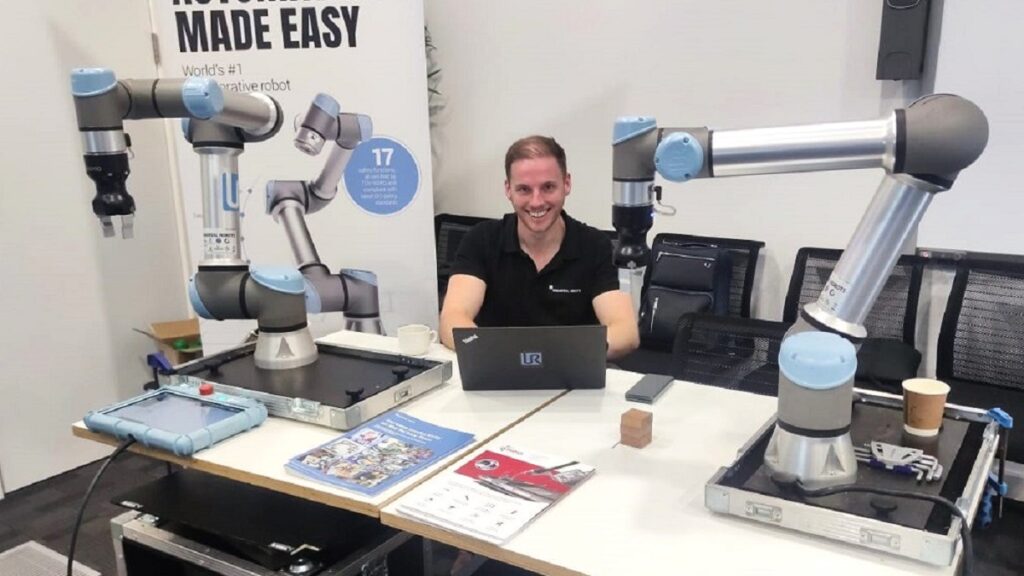Yesterday (18th April) UWE Bristol opened their doors to more than students as they invited engineers and business people to network and connect at its Make UK Manufacturing Connect event. Having pulled around 100 attendees and dozens of exhibitors into its Robotics Laboratory, the event highlighted the pertinence of the topic.
The conference, featuring 12 speakers, was broken into three sessions, with each session talking on a separate issue. After attendees were given a welcome to the day by UWE and Make UK representatives, the talks began. First up, the opportunities of digitalising the manufacturing industry.
“The massive advantage of doing this is that we can have a fully flexible manufacturing system.” Rob Key of Siemens Digital Industries told the auditorium, as he highlights how Siemens has begun manufacturing digitalisation into their manufacturing process. Where digitalisation is being utilised in some areas of manufacturing is to design, build and run the manufacturing process all in the digital world. This pre-process can lead to savings in costs and also the discovery of further optimisations of the process. This highlighted a key synergy of the day as many in attendance were coming to the conference from a business orientated background.
But it’s not just costs to be considered when choosing to further integrate tech into manufacturing process. No, as the following session would explain, there was an existential imperative. The word on every business’ radar: climate change.
“How is your supply chain going to cope with a climate changed world? What do you have to plan to prepare for that?” UWE Professor Jim Longhurst posed to the audience. The outlook on climate change is proving grim, with climate scientists warning a key global temperature goal will likely be missed. Flooding in China disrupting coal supply chains, droughts in Germany effecting the shipping of raw materials, a hurricane in Florida effecting plastic production, the list of real, already occurring events causing disruptions are plain to see. How then, could green technology mitigate some of these disasters? With the implementation of green energy, supply shocks to traditional hydrocarbon sources can be minimised, and material shortages can be better absorbed as processes are optimised and less waste generated in production.
Lastly, the final group of talks talked about an equally pertinent, but perhaps more chronic problem in manufacturing: labour shortages, both skilled and unskilled.
“We know we’re not inspiring enough people to get into engineering.” Professor Lisa Brodie said. Speaking from a deeper societal standpoint, Brodie explained how she has helped initiatives try to solve the issue at its core, by trying to inspire kids to think of engineering as a career. These efforts have seen her put popular video games into an engineering scope and even create Top Trumps like cards with accompanying TikToks too to reach children. Yet, with that strategy still yet to yield results, the conversation moved on to current efforts being implemented, particularly those aimed at addressing unskilled labour shortages.
Highlighting the eclectic mix of engineering and business types that the day’s talks pertained to, former Senior Associate at J.F. Lehman & Co. venture capital company Troy Barratt, now Managing Director at Contracts Engineering, told the audience about the company’s journey integrating ‘cobots’ to its manufacturing process in efforts to increase output and productivity, as well as the company’s plans to further integrate robots into its processes.
As the day of talks and panel discussions came to a close, attendees were invited to tour UWE’s coveted robotics laboratory, which has been involved in some high-profile projects, such as the development of connected autonomous vehicles for the elderly, wearable robotic tools for surgery, and a social robot called Pepper being used to helps autistic pupils at a school.
There’s also plenty of other news editorials at IoT Insider’s sister publication, Electronic Specifier. And you can always add to the discussion at our comments section below or on our LinkedIn page here.
